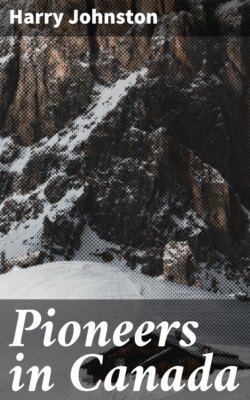Pioneers in Canada

Реклама. ООО «ЛитРес», ИНН: 7719571260.
Оглавление
Harry Johnston. Pioneers in Canada
Pioneers in Canada
Table of Contents
PREFACE
List of the Chief Authorities
CHAPTER I
The White Man's Discovery of North America
CHAPTER II
Jacques Cartier
JACQUES CARTIER
CHAPTER III
Elizabethan Pioneers in North America
ICEBERGS AND POLAR BEARS
CHAPTER IV
Champlain and the Foundation of Canada
SAMUEL DE CHAMPLAIN and ALEXANDER HENRY THE ELDER
CHAPTER V
After Champlain: from Montreal to the Mississippi
INDIANS HUNTING BISON
CHAPTER VI
The Geographical Conditions of the Canadian Dominion
INDIANS LYING IN WAIT FOR MOOSE
CHAPTER VII
The Amerindians and Eskimo: the Aborigines of British North America
AN AMERINDIAN TYPE OF BRITISH COLUMBIA
CARIBOU SWIMMING A RIVER
GREAT AUKS, GANNETS, PUFFINS, AND GUILLEMOTS
CHAPTER VIII
The Hudson Bay Explorers and the British Conquest of all Canada
CHAPTER IX
The Pioneers from Montreal: Alexander Henry the Elder
SCENE ON CANADIAN RIVER: WILD SWANS FLYING UP DISTURBED BY BEAR
CHAPTER X
Samuel Hearne
LAKE LOUISE, THE ROCKY MOUNTAINS
SAMUEL HEARNE and ALEXANDER MACKENZIE
CHAPTER XI
Alexander Mackenzie's Journeys
BIG-HORNED SHEEP OF ROCKY MOUNTAINS
THE UPPER WATERS OF THE FRASER RIVER
CHAPTER XII
Mackenzie's Successors
THE KOOTENAY OR HEAD STREAM OF THE COLUMBIA RIVER
A HUNTER'S 'SHACK' IN BRITISH COLUMBIA: AFTER A SUCCESSFUL SHOOT OF BLUE GROUSE
Отрывок из книги
Harry Johnston
Published by Good Press, 2019
.....
In 1496 King Henry VII provided money to cover some of the expense of a voyage of discovery to search for the rumoured island across the ocean. The people of Bristol were ordered to assist John Cabot, and by them he was furnished with a small sailing ship, the Matthew, and a crew of fifteen mariners. Cabot, with his two sons, Luis and Sancio, sailed for Ireland and the unknown West in May, 1497, and, after a sea voyage quite as wonderful as that of Columbus, reached the coast of Cape Breton Island (or "the New Isle", as it was first named[6]) on June 24, 1497. They found "the land excellent, and the climate temperate". The sea was so full of fish along these coasts that the mariners opined (truly) that henceforth Bristol need not trouble about the Iceland trade. Here along this "new isle" were the predestined fisheries of Britain.[7]
They encountered no inhabitants, though they found numerous traces of their existence in the form of snares, notched trees, and bone netting needles. John Cabot hoisted the English flag of St. George and the Venetian standard of St. Mark; then—perhaps after coasting a little along Nova Scotia—fearful that a longer stay might cause them to run short of provisions, he turned the prow of the Matthew eastward, and reached Bristol once more about August 6, and London on August 10, 1497, with his report to King Henry VII, who rewarded him with a donation of £10. He was further granted a pension of £20 a year (which he only drew for two years, probably because he died after returning from a second voyage to the North-American coast), and he received a renewal of his patent of discovery in February, 1498. In this patent it is evidently inferred that King Henry VII assumed a sovereignty over these distant regions because of John Cabot's hoisting of the English flag on "the new Isle" (Cape Breton Island) in the preceding year.
.....